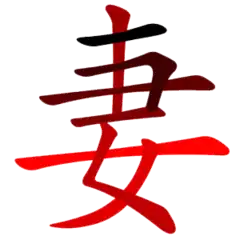妻
| ||||||||
Translingual
| Stroke order | |||
|---|---|---|---|
 | |||
Han character
妻 (Kangxi radical 38, 女+5, 8 strokes, cangjie input 十中女 (JLV), four-corner 50404, composition ⿱⿻一肀女)
References
- Kangxi Dictionary: page 257, character 30
- Dai Kanwa Jiten: character 6140
- Dae Jaweon: page 522, character 25
- Hanyu Da Zidian (first edition): volume 2, page 1036, character 2
- Unihan data for U+59BB
Chinese
| trad. | 妻 | |
|---|---|---|
| simp. # | 妻 | |
| alternative forms | 𪥼 | |
Glyph origin
| Historical forms of the character 妻 | ||
|---|---|---|
| Western Zhou | Shuowen Jiezi (compiled in Han) | Liushutong (compiled in Ming) |
| Bronze inscriptions | Small seal script | Transcribed ancient scripts |
 |
 |
 |
Ideogrammic compound (會意/会意) : 肀 (“hand grabbing hair”) + 女 (“woman”) ― a man grabbing a woman's hair to show ownership (marriage by capture).
Etymology
Thought to be cognate to 齊 (OC *dzêi, “same, equal (adj.), in line”) (SWJZ; Karlgren, 1956) & interpreted as "an equal to her husband"; yet this is unlikely considering the realities of ancient societies (Schuessler, 2007).
Schuessler instead proposes Austroasiatic etymology: he reconstructs 妻 (OC *tshə̂i) < *k-sə̂i and compares it to Middle Khmer [script needed] (kansai, “wife”) (whence Khmer កន្សៃ (kɑnsay, “wife”)) and Khmer [script needed] (*khsay, “be female”) with *ka(n)- being a female marker (ibid.).
Pronunciation 1
Synonyms
Compounds
- 下堂妻
- 下妻 (Xiàqī)
- 三妻四妾 (sānqīsìqiè)
- 令妻
- 休妻 (xiūqī)
- 借妻
- 停妻再娶
- 偎妻靠婦/偎妻靠妇
- 傍妻
- 兄弟共妻
- 兒女夫妻/儿女夫妻
- 兩婦三妻/两妇三妻
- 出妻
- 初妻
- 前妻 (qiánqī)
- 大婦小妻/大妇小妻
- 夫妻 (fūqī)
- 夫妻兩口/夫妻两口
- 夫妻反目
- 夫妻店 (fūqīdiàn)
- 夫妻相 (fūqīxiàng)
- 夫妻關係/夫妻关系
- 夫榮妻貴/夫荣妻贵
- 夫榮妻顯/夫荣妻显
- 夫貴妻榮/夫贵妻荣
- 妻以夫貴/妻以夫贵
- 妻兒/妻儿 (qī'ér)
- 妻兒老小/妻儿老小
- 妻女 (qīnǚ)
- 妻妾 (qīqiè)
- 妻姊妹婚
- 妻子
- 妻孥 (qīnú)
- 妻室 (qīshì)
- 妻小 (qīxiǎo)
- 妻梅子鶴/妻梅子鹤
- 妻管嚴/妻管严 (qīguǎnyán)
- 妻舅 (qījiù)
- 妻親/妻亲
- 妻離子散/妻离子散 (qīlízǐsàn)
- 妻黨/妻党
- 娶妻 (qǔqī)
- 娶妻生子 (qǔqīshēngzǐ)
- 嫡妻 (díqī)
- 嬌妻/娇妻 (jiāoqī)
- 嬌妻美妾/娇妻美妾
- 孀妻 (shuāngqī)
- 寡妻 (guǎqī)
- 封妻廕子/封妻荫子
- 小妻
- 山妻 (shānqī)
- 後妻/后妻 (hòuqī)
- 徙宅忘妻
- 忌妻
- 患難夫妻/患难夫妻
- 愛妻/爱妻 (àiqī)
- 拋妻別子/抛妻别子
- 拋妻棄子/抛妻弃子 (pāoqīqìzǐ)
- 挑妻窩夫/挑妻窝夫
- 指腳夫妻/指脚夫妻
- 旁妻
- 未婚妻 (wèihūnqī)
- 杞梁妻
- 柴米夫妻
- 梅妻鶴子/梅妻鹤子 (méiqīhèzǐ)
- 次妻 (cìqī)
- 正妻 (zhèngqī)
- 殺妻求將/杀妻求将
- 活人妻
- 焦仲卿妻
- 蒸藜出妻
- 玄妻
- 秋胡戲妻/秋胡戏妻
- 空中夫妻
- 糟糠之妻 (zāokāngzhīqī)
- 糟糠妻
- 結髮夫妻/结发夫妻 (jiéfà fūqī)
- 繼妻/继妻
- 老夫妻
- 老夫老妻 (lǎofūlǎoqī)
- 腹婚妻
- 腳頭妻/脚头妻
- 花燭夫妻/花烛夫妻
- 荊妻/荆妻
- 萊妻/莱妻
- 蔭子封妻/荫子封妻
- 買妻恥樵/买妻耻樵
- 賢妻/贤妻 (xiánqī)
- 賢妻良母/贤妻良母 (xiánqīliángmǔ)
- 賣妻鬻子/卖妻鬻子
- 質妻鬻子/质妻鬻子
- 逃妻
- 雇妻鬻子
- 露水夫妻
- 頭妻/头妻
- 首妻
- 髮妻/发妻 (fàqī)
Pronunciation 2
Definitions
妻
- † to give a wife to; to give as a wife; to become married to a man
- 子謂公冶長,「可妻也。雖在縲絏之中,非其罪也」。以其子妻之。 [Classical Chinese, trad.]
- From: The Analects of Confucius, c. 475 – 221 BCE
- Zǐ wèi Gōngyě Cháng, “kě qì yě. Suī zài léiyì zhī zhōng, fēi qí zuì yě”. Yǐ qí zǐ qì zhī. [Pinyin]
- The Master said of Gongye Chang that he might be wived; although he was put in bonds, he had not been guilty of any crime. Accordingly, he gave him his own daughter to wife.
子谓公冶长,「可妻也。虽在缧绁之中,非其罪也」。以其子妻之。 [Classical Chinese, simp.]
- † to marry a woman
- 好色,人之所欲,妻帝之二女,而不足以解憂; [Classical Chinese, trad.]
- From: Mencius, c. 4th century BCE
- hǎosè, rén zhī suǒyù, qī dì zhī èrnǚ, ér bùzú yǐ jiěyōu; [Pinyin]
- To lust after feminine beauty is men's desire, and Shun married as wives Emperor Yao's two daughters, yet that was not enough to rid Shun of Shun's sorrow.
好色,人之所欲,妻帝之二女,而不足以解忧; [Classical Chinese, simp.]
Japanese
Etymology 1
| Kanji in this term |
|---|
| 妻 |
| つま Grade: 5 |
| kun’yomi |
From 端 (tsuma, “side, edge”), indicating the person who is at the side of someone: a spouse.[1] Compare the English expression better half.
This term originally referred to either a male (husband) or female (wife) spouse. In modern usage, this term refers only to a female spouse.[1]
Alternative forms
- 夫 (archaic)
Noun
妻 • (tsuma)
- (archaic) a spouse
- (humble, only refers to one's own) a wife (married woman)
- 1999 February 15 [1983 June 20], Osamu Tezuka, “第8話 未知への挑戦 [Chapter 8: Challenge of the Third Kind]”, in ブラック・ジャック [Black Jack], 8th edition, volume 18 (fiction), Tokyo: Kodansha, →ISBN, page 176:
- 先生………………私の妻は美しいでしょう?
- Sensei……………… watashi no tsuma wa utsukushii deshō?
- Doctor... Do you think my wife is beautiful?
- Ā! Subarashii bijin desu yo!
- Sure! She’s a gorgeous lady!
- 先生………………私の妻は美しいでしょう?
Synonyms
Noun
妻 • (sai)
- my wife
- Isikawa Takuboku, Romazi Nikki
- Yo wa Sai wo aisiteru; aisiteru kara koso kono Nikki wo yomase taku nai no da.
- I love my Wife; it is precisely because I love her that I do not want her to read this Diary.
- Isikawa Takuboku, Romazi Nikki
Usage notes
- Used chiefly in written texts such as letters.
References
- Shōgaku Tosho (1988) 国語大辞典(新装版) [Unabridged Dictionary of Japanese (Revised Edition)] (in Japanese), Tōkyō: Shogakukan, →ISBN
- Matsumura, Akira, editor (2006), 大辞林 [Daijirin] (in Japanese), Third edition, Tōkyō: Sanseidō, →ISBN
Korean
Etymology
From Middle Chinese 妻 (MC tshej).
| Historical Readings | ||
|---|---|---|
| Dongguk Jeongun Reading | ||
| Dongguk Jeongun, 1448 | 촁 (Yale: chyèy) | |
| Middle Korean | ||
| Text | Eumhun | |
| Gloss (hun) | Reading | |
| Hunmong Jahoe, 1527 | 겨〯집 (Yale: kyěcìp) | 쳐 (Yale: chyè) |
Pronunciation
- (SK Standard/Seoul) IPA(key): [t͡ɕʰʌ̹]
- Phonetic hangul: [처]